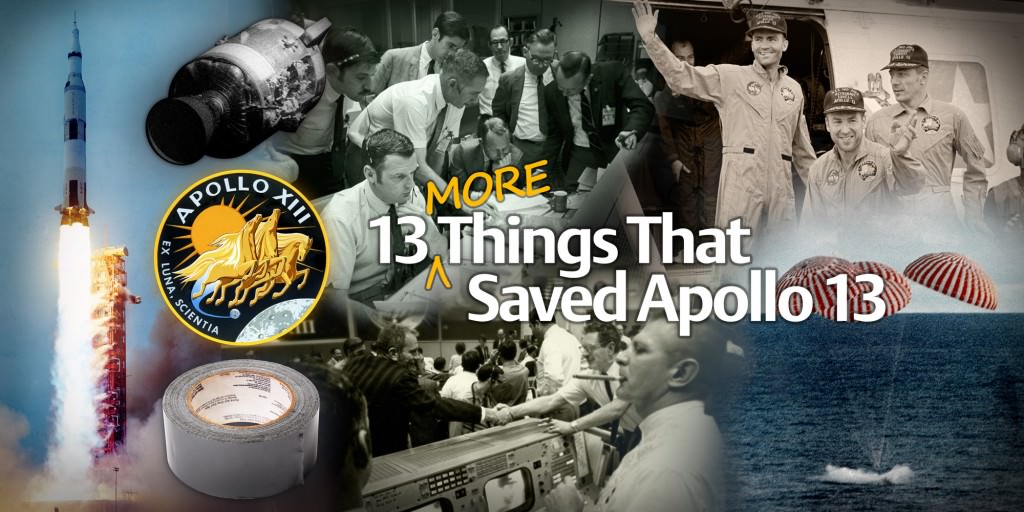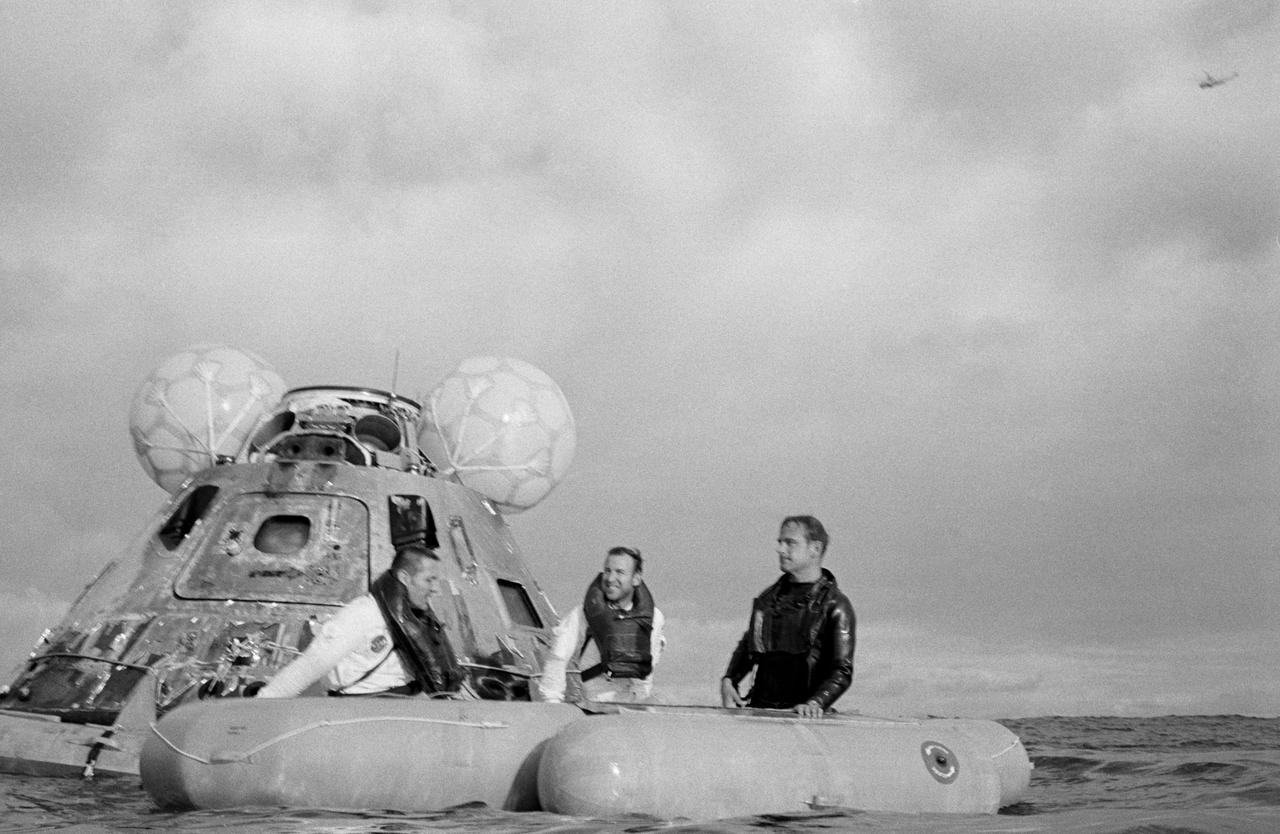50 years ago today, on April 17, 1970, the crew of Apollo 13 came home. Safely. Successfully.
The world breathed a collective sigh of relief as they watched NASA turn a disaster into one of the most dramatic happy-endings ever.
The flight of Apollo 13 was unlike any other Apollo mission, and the final hours of the flight – preparing for and implementing the reentry to Earth – was unlike any other, as well.
The crew had to execute a 500-plus item checklist that had been written only hours before. They were in constant contact with the Mission Control team to verify each step. The crew — exhausted, cold and dehydrated — needed to perform multiple unplanned maneuvers, including emergency trajectory correction using the Lunar Module (LM) thrusters.
After the final trajectory correction maneuver as the spacecraft headed towards Earth, tracking data from Earth showed the burn had been performed precisely as hoped. However, following that maneuver, the crew had to make sure they didn’t perform any extra thruster firings, as the LM Reaction Control System fuel supply was nearing a low point where accurate measurements were no longer reliable. Everyone wanted to make sure they had enough fuel for the final stretch towards Earth.
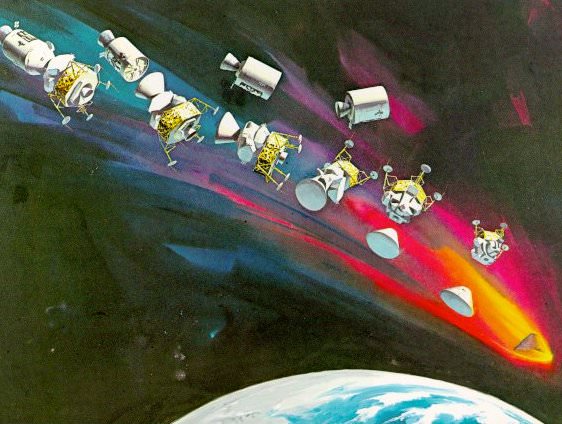
Then the crew had to make sure they turned systems back on in the cold Command Module in the right sequence – and turned off any extra accessories like floodlights – to ensure the CM batteries would last through reentry. At least one of the three batteries was predicted to fail about the time the parachutes needed to deploy. (Read about how the batteries were recharged here.)
And of course, in a typical Apollo spaceflight, the astronauts would have jettisoned the LM while still in lunar orbit. But the use of the LM Aquarius was necessary until nearly the very end of the mission, as it was the lifeboat for the astronauts, keeping them alive in lieu of the crippled Command Module, inoperable following the explosion of an oxygen tank in the attached Service Module.
Therefore, the sequence of reentry events was quite unusual. The Service Module was actually jettisoned before the LM. The SM jettison had some extra drama to it, in addition to the problems encountered for Apollo 13.
As I wrote in my book “Eight Years to the Moon: The History of the Apollo Missions,” NASA electrical engineer Gary Johnson shared documents that revealed a reentry anomaly had been discovered following the Apollo 11 mission, where the SM did not separate correctly from the CM. A series of thruster firings on the SM should have moved the two vehicles apart, but an improper sequencing of the thruster firings brought the SM back towards the CM, and the crew of Apollo 11 reported seeing the SM fly past them. An investigation revealed the anomaly had not only occurred on Apollo 11, but other previous Apollo flights as well.
Johnson presented to the Apollo Program Configuration Control Panel the changes to the electronics in order to change the sequence of the thruster firing, and he recalls trying to get the engineering changes made as soon as possible, so it could be done starting with Apollo 12. But by the time the investigation and analysis of how to fix the problem was completed, it was nearly time for Apollo 12’s launch, and the Apollo Program made the decision to launch Apollo 12 without this change being made. The SM Jettison Controller changes were approved and completed for the flight of Apollo 13, as well as for subsequent missions.
But the updated separation sequence would not happen on Apollo 13. The Service Module for Apollo 13 was dead, with its thrusters inoperable following the explosion. According to the Apollo Flight Journal, this sequence of events needed to take place for SM sep: First the electric connections between the SM and CM were cut using explosive bolts, and then another explosive guillotine separated the Service Module Umbilical from the Command Module. Then three charges cut the tension ties that held the Service and Command Modules together, and create a spring action that pushes the CM away.
In order to put as much distance between the SM and the CM and attached LM, the crew needed to manually fire the LM RCS jets to first separate them, then to turn around in a manner that allowed the crew to observe and photograph the Service Module.
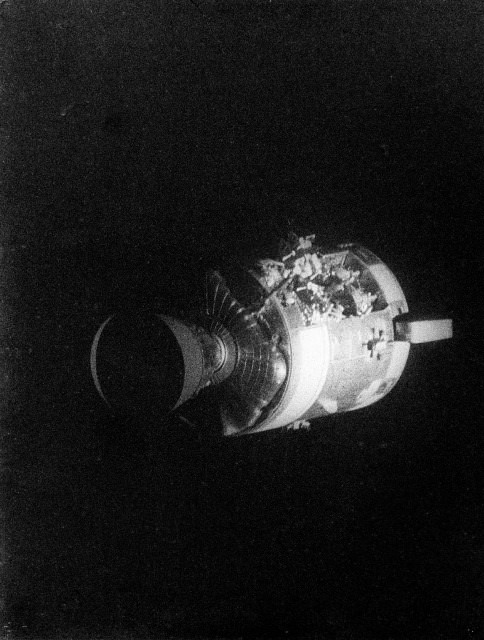
“And there’s one whole side of that spacecraft missing,” Jim Lovell famously radioed down to the ground, disbelief in his voice at the sight of the battered SM.
When it came time to jettison the LM Aquarius, the crew was in the now-powered-up CM Odyssey. Odyssey had no maneuvering capability, with no fuel for the RCS thrusters. They had to jettison the LM in such a way that the Lunar Module would not collide with the Command Module or endanger it any way. NASA engineers and flight controllers had to work on a procedure suggested by Retrofire Officer (RETRO) Chuck Deiterich, using the pressure in the docking tunnel between the two craft to act as a spring to push them apart.
Normally, the two spacecraft were separated using an explosive charge. In a nominal flight, the tunnel would have been depressurized before separation. But with the tunnel still pressurized, the explosives could endanger Odyssey’s hatch and put the astronauts at risk during re-entry.
Their plan worked perfectly. Capcom Joe Kerwin poignantly radioed from Mission Control, “Farewell Aquarius, and we thank you.”
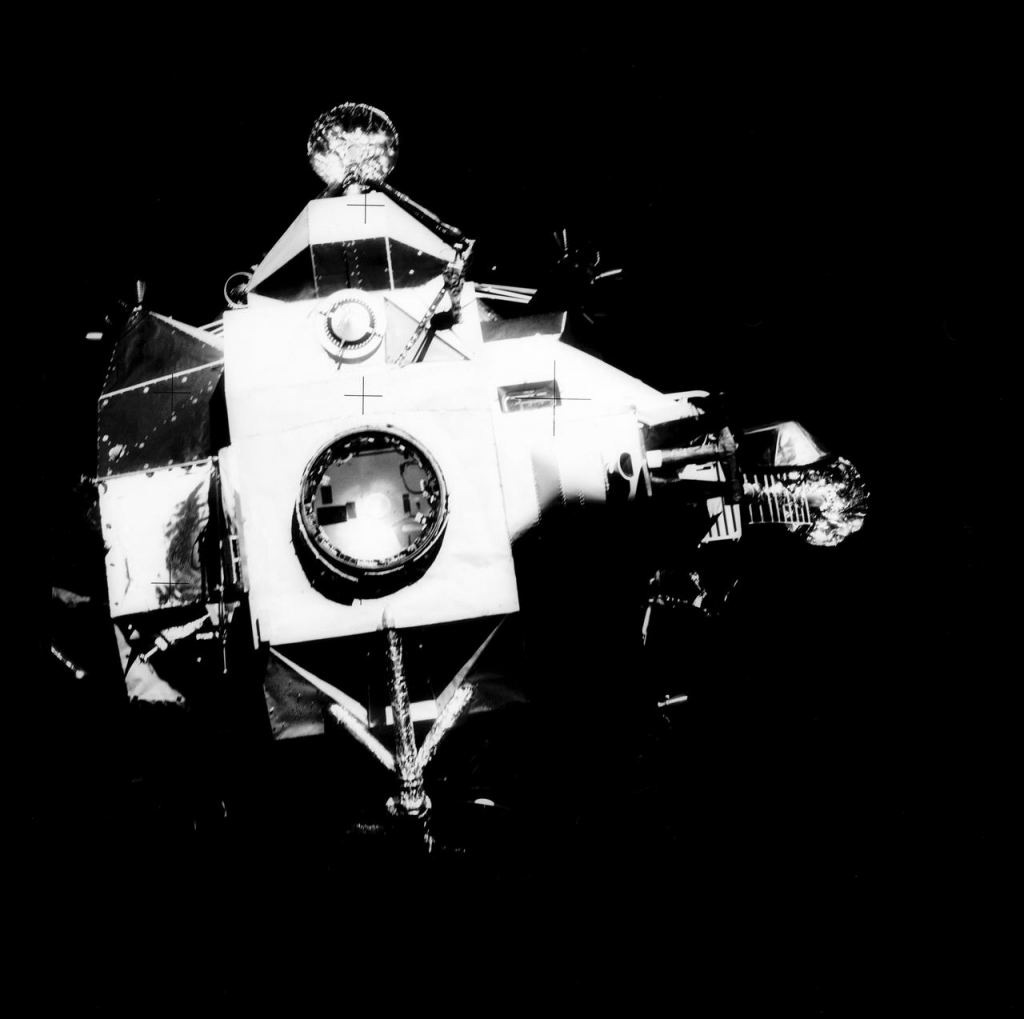
The crew then made their final preparations to make that final, fiery leg back home. All anyone could do now was hope that every procedure and last-minute calculation had been correct.
When the crew plummeted through Earth’s atmosphere, communications with Mission Control were impossible. During the Apollo era, the radio blackout was a normal part of reentry, caused by ionized air surrounding the CM during its superheated reentry through the atmosphere, which interfered with radio waves. For virtually every reentry from Mercury through Apollo 12, the time of radio blackout was predictable, almost to the second. However, Apollo 13’s radio blackout period was nail-bitingly long: it extended for approximately 87 seconds longer than expected.
Five years ago, in a previous “13 Things” series, we discussed possible reasons for why the blackout period was excruciatingly long. The mostly likely explanation was that the spacecraft was coming in on a shallower trajectory than expected. This would result in a longer period in the upper atmosphere where there was less deceleration of the spacecraft. In turn, the reduced pace of deceleration lengthened the time that the heat of reentry produced the ionized gasses that would block communications.
But why was the trajectory shallower than expected? NASA engineers and flight controllers have been asking that question for 50 years. A group headed by Apollo Flight Dynamics Officer (FIDO) Dave Reed, Retrofire Officer (RETRO) Chuck Deiterich and Electrical, Environmental and Communication systems (EECOM) John Aaron recently conducted an exhaustive review of the data, and used computer modeling to recreate every detail of the events leading to reentry. Their conclusion? Blame excess venting from a cooling system on the LM.
“Our model was fairly complex,” Reed told Universe Today, “with many adjustable variables, such as the Passive Thermal Control (PTC) actual orientation and rate, trajectory relationship to PTC orientation, sublimator vent diagram and photos, estimates of the percent of propulsion from ‘non-propulsive’ vents, O2 venting contributions, hydrogen leak potential, velocity effects on entry angle at various distances from entry, helium venting, hot side and cold side sublimation physics, and duration of venting.”
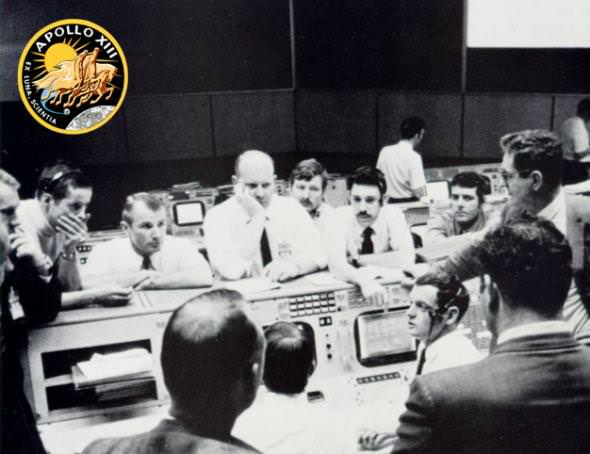
Reed said that after studying all the identified possibilities and modeling the venting momentum of various systems, “it is evident that the delta velocity needed to cause the observed trajectory shallowing from the CSM LM stack, was primarily from the Lunar Module cooling system,” he said. “Additional leak sources were present however, both from the SM hydrogen tanks located beneath the damaged O2 tanks, and the remaining O2 tank as well.”
Reed, Deiterich and Aaron wrote that their conclusions match the real-time data from the mission, and is supported by “a string of transmissions from the crew reporting on again, off again, venting and ‘sparkles’ coming from the CSM (which would have been triggered by PTC hot-cold cycles) and by calculations of maximum momentum that could be generated by the LM cooling system as well as any venting from the SM hydrogen and oxygen tanks.”
In this video, you can sense the palpable concern in Mission Control over the lengthy communications blackout. And contrary to the final scenes in the movie “Apollo 13” the flight controllers, flight directors and all those present in Mission Control did not begin to celebrate until the parachutes deployed and the crew slowly and safely splashed down in the South Pacific Ocean.
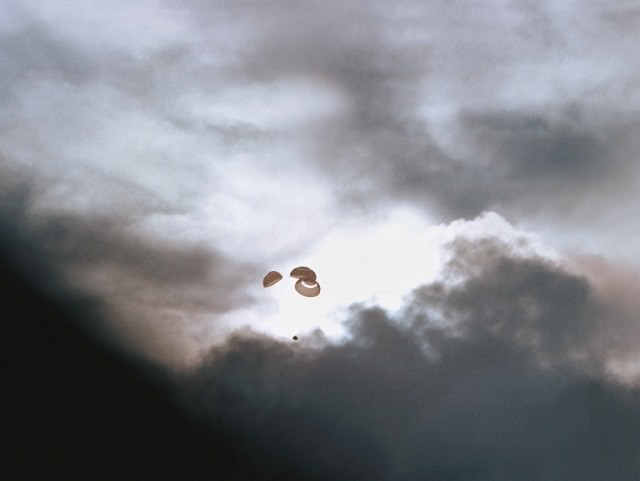
“During the blackout,” Reed recalled, “I distinctly remember looking at Chuck (Deiterich) with the stark realization that if we — Chuck and myself — had used an errant vector to compute the last mid-course correction, and that if the crew didn’t survive……it was just the two of us who would have been responsible. I can tell you that for those excess 90 seconds of blackout, all the gravity in Houston was beneath our feet. Celebrate hell. I don’t have any way of expressing the horror of those seconds, nor my relief when I saw the crew on the chutes.”
Our thanks to NASA engineer Jerry Woodfill for his ideas and insights for all of our series of articles on Apollo 13 starting with “13 Things That Saved Apollo 13,” and then “13 MORE Things That Saved Apollo 13.”
Additional thanks to NASA engineers Norm Chaffee and Gary Johnson and flight controllers Dave Reed and Chuck Deiterich for their insights and recollections for this current series:
Part 1: The Barbecue Roll, and Part 2: Charging the Batteries.
